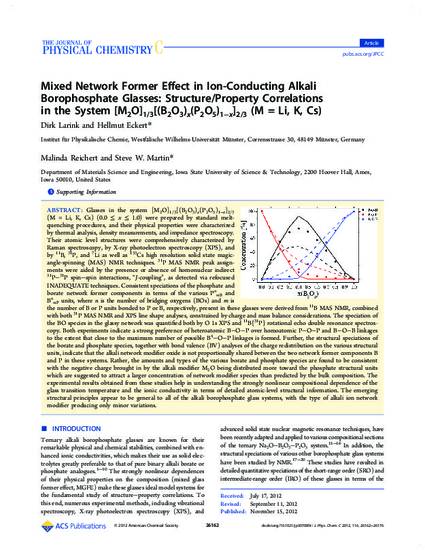
Glasses in the system [M2O]1/3[(B2O3)x(P2O5)1–x]2/3(M = Li, K, Cs) (0.0 ≤ x ≤ 1.0) were prepared by standard melt-quenching procedures, and their physical properties were characterized by thermal analysis, density measurements, and impedance spectroscopy. Their atomic level structures were comprehensively characterized by Raman spectroscopy, by X-ray photoelectron spectroscopy (XPS), and by 11B, 31P, and 7Li as well as 133Cs high resolution solid state magic-angle-spinning (MAS) NMR techniques. 31P MAS NMR peak assignments were aided by the presence or absence of homonuclear indirect 31P–31P spin–spin interactions, “J-coupling”, as detected via refocused INADEQUATE techniques. Consistent speciations of the phosphate and borate network former components in terms of the various PnmB and BnmPunits, where n is the number of bridging oxygens (BOs) and m is the number of B or P units bonded to P or B, respectively, present in these glasses were derived from 11B MAS NMR, combined with both 31P MAS NMR and XPS line shape analyses, constrained by charge and mass balance considerations. The speciation of the BO species in the glassy network was quantified both by O 1s XPS and 11B{31P} rotational echo double resonance spectroscopy. Both experiments indicate a strong preference of heteroatomic B–O–P over homoatomic P–O–P and B–O–B linkages to the extent that close to the maximum number of possible B4–O–P linkages is formed. Further, the structural speciations of the borate and phosphate species, together with bond valence (BV) analyses of the charge redistribution on the various structural units, indicate that the alkali network modifier oxide is not proportionally shared between the two network former components B and P in these systems. Rather, the amounts and types of the various borate and phosphate species are found to be consistent with the negative charge brought in by the alkali modifier M2O being distributed more toward the phosphate structural units which are suggested to attract a larger concentration of network modifier species than predicted by the bulk composition. The experimental results obtained from these studies help in understanding the strongly nonlinear compositional dependence of the glass transition temperature and the ionic conductivity in terms of detailed atomic-level structural information. The emerging structural principles appear to be general to all of the alkali borophosphate glass systems, with the type of alkali ion network modifier producing only minor variations.
Available at: http://works.bepress.com/steve_martin/11/

Reprinted with permission from The Journal of Physical Chemistry C 116 (2012): 26162–26176, doi:10.1021/jp307085t. Copyright 2012 American Chemical Society